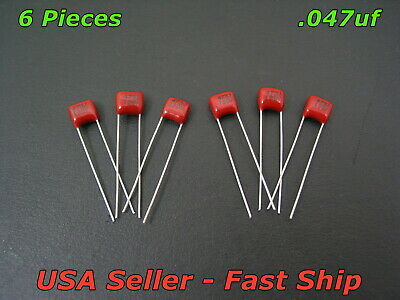-40%
6 Pcs .047uf 100v Guitar CBB Polypropylene Tone Capacitors 473 47nf 2A473J Cap
$ 3.68
- Description
- Size Guide
Description
6 Pcs .047uf 100v Guitar CBB Polypropylene Tone Capacitors 473 47nf 2A473J CapBrand New, 6 pieces.
Made of the same material as the 715P Orange Drop capacitors (polypropylene).
A bit smaller than orange drops and provide the same quality tone that polypropylene is know for.
Fast Ship, USPS First Class Package
...................................................................................................................
Capacitor Voltage Ratings - Is More Better?
No, more is not better. The voltage rating on a capacitor simply indicates the maximum amount of voltage that the cap can handle. Guitars have very low voltage circuitry. In theory, every capacitor with a voltage rating of say 1 volt or higher will work in a passive electric guitar. Usually as the voltage rating increases, so does the physical size of the capacitor. One reason for the higher voltage tone caps that you find in some guitars is because a lot of popular caps like the Sprague Orange Drops were used in tube amps with higher voltage requirements; such as 600v or more. These caps sound great in a guitar, but they are huge. An Orange Drop cap with a 10v volt rating would sound just as great. So, whether it is a 50 volt cap, a 100 volt cap, or a 600 volt cap, it would sound the same.
About CBB (Polypropylene) Capacitors:
The CBB capacitor is a polypropylene capacitor, in which a metal foil is used as and electrode, and a polypropylene film is stacked from both ends and then wound into a cylindrical structure. Characteristics include: non-polar, high insulation resistance, excellent frequency characteristics, and low dielectric loss.
CBB (polypropylene) capacitors exhibit very little change of capacitance with time and voltage applied, making them ideal for applications where a stable level of capacitance is needed. It is found that the temperature coefficient is low, negative and virtually linear.
CBB capacitors find uses in many areas of electronics: Circuits with high peak current levels; High frequency resonant circuits; Premium audio applications where many enthusiast believe they offer better performance and hence a better sound quality; High frequency pulse discharge circuits, and energy storage circuits; their high resistance enables low levels of self-discharge.










